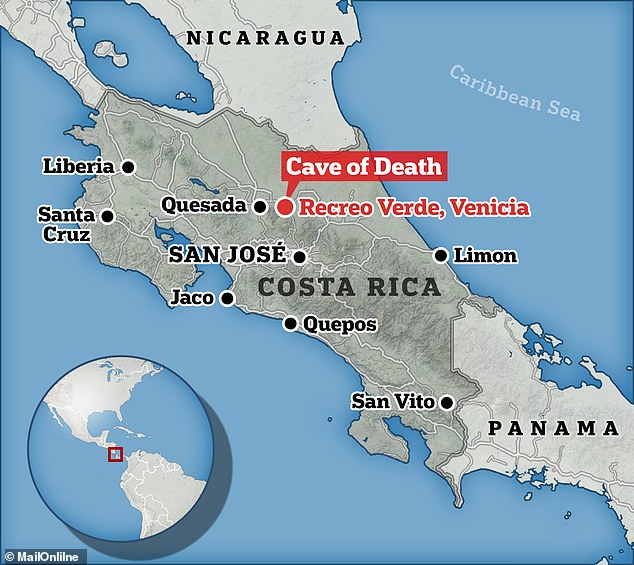Beware of the ‘Cave of Death’: Terrifying cavern appears harmless to the naked eye – but instantly kills any creature that enters it
From the entrance it almost looks like a normal cave, with a rocky overhang and leaves scattered around the entrance.
The only giveaway is a warning sign decorated with deadly skulls and crossbones that reads, “Danger! Do not enter from here.’
This is Costa Rica’s Cave of Death – or ‘Cueva de la Muerte’ in local Spanish – located at the Recreo Verde tourist complex in the Venecia district.
At 8 feet deep and almost 30 feet long (2 by 3 meters), it instantly kills any creature that enters it.
However, this doesn’t stop brave explorers from visiting the site in search of social media videos.
Visitors to the Cave of Death demonstrate its power by holding a lit torch near the entrance. Note the warning sign, decorated with deadly skulls and crossbones, that reads: ‘Danger! Do not enter from here’

The Cave of the Death – or ‘Cueva de la Muerte’ in local Spanish – is located in the Recreo Verde tourist complex in the Venecia district, Costa Rica
According to Belgium-based cave explorer Guy van Rentergem, who visited the site several years ago, it contains a significant amount of carbon dioxide (CO2).
In fact, the levels of the gas in the cave are so high that it can cause almost instantaneous unconsciousness, followed by cessation of breathing.
Fortunately, people are generally safe as it’s too small to fit in – and campsite signs give plenty of warning.
However, snakes, birds, rodents and other small creatures die quickly after they unknowingly wander into the entrance, perhaps in search of food.
“This is a very small cave, but it is unusual because there is a significant amount of carbon dioxide gas coming out of the far slit at the back of the cave,” Van Rentergem said.

In a video on YouTube, Belgium-based cave explorer Guy van Rentergem (photo) explains why the cave is so dangerous
“Small animals enter the cave and suffocate, usually within moments.”
About 30kg of carbon dioxide is emitted from the trench into the atmosphere every hour – equivalent to an average car driving 256km, the expert added.
‘In one year this is 263 tonnes of carbon dioxide or equivalent to a car traveling 2.2 million km or driving around the world 56 times.’
It is unclear where exactly the gas comes from, although Van Rentergem says it is of volcanic origin.
During his visit to the Cave of Death, one of Van Rentergem’s crew demonstrates the cave’s potential by holding a burning torch at the entrance.
After just a few seconds, the flame goes out – and that’s because CO2 displaces the oxygen around the fire, causing it to burn.
Because CO2 is heavier than air, concentrations of the gas are higher closer to the cave floor – an additional danger factor for small animals.
a 2022 study Italian researchers pointed out that natural caves are particularly susceptible to ‘dangerous CO2 accumulations’.
That’s because they promote the release of ‘geogenic’ CO2 into the atmosphere – that is, CO2 that comes from the Earth’s geological processes.
“Atmospheric CO2 concentrations can reach high levels in natural caves, posing a dangerous condition for both people visiting the underground environment,” the study authors said.
In general, the toxicity of CO2 in high concentrations is not well known, meaning that people visiting such caves may underestimate the dangers.
Other caves with high levels of gas include Movile Cave in Romania and Carburangeli Cave in Italy.
Famously, Peak Cavern in Derbyshire was the site of a tragic accident in 1959 involving British student Neil Moss.
The 20-year-old University of Oxford student lost consciousness after inhaling CO2 – although this was thought to be the result of his own breathing building up at the bottom of the cave shaft.
